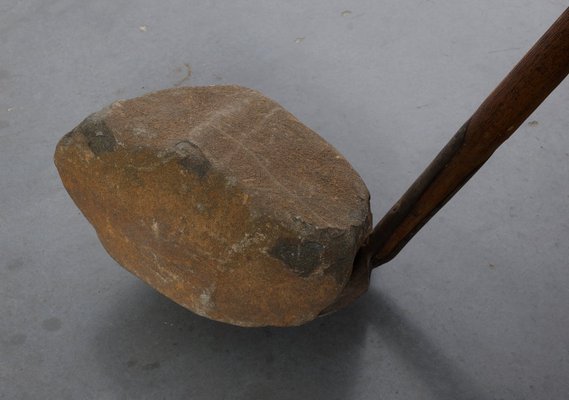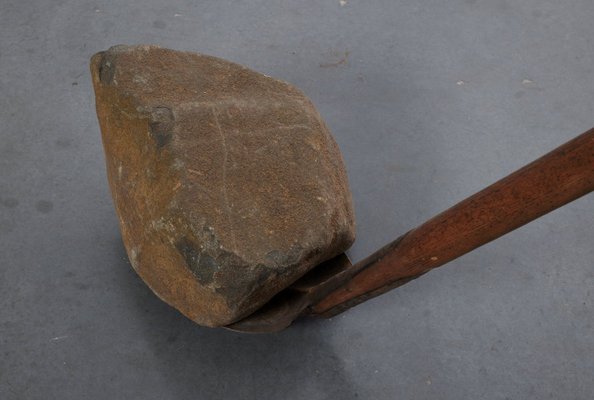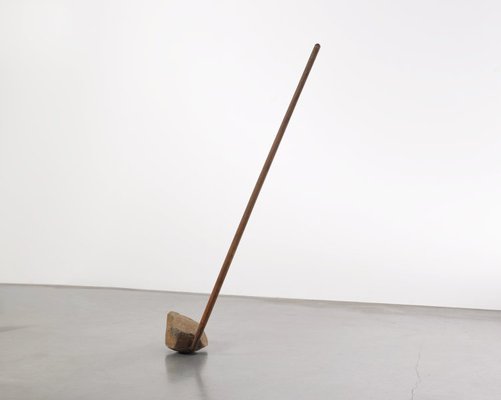



-
Details
- Date
- 2015
- Media category
- Sculpture
- Materials used
- found object assemblage; rock and shovel
- Dimensions
- 254.0 x 21.6 x 22.9 cm
- Signature & date
Signed l.c. Certificate of authenticity, black fibre-tipped pen "Lonnie B. Holley". Not dated.
- Credit
- Purchased with funds provided by the Mervyn Horton Bequest 2021
- Location
- Not on display
- Accession number
- 165.2021.a-b
- Copyright
- © Lonnie Holley
- Artist information
-
Lonnie Holley
Works in the collection
- Share
-
-
About
Lonnie Holley is a one-of-a-kind contemporary American creator. Born the seventh of twenty-seven children in Jim Crow-era Birmingham, Holley had an itinerant and difficult childhood whose challenges underpin and inform the deeply personal, political and stirring art that he creates today.
Holley’s renown is based in part on his work as a musician, creating improvised and lyrically rich songs of survival, endurance, resistance, spirituality and planetary care. The titles ‘Looking for all (all rendered truth)’, ‘Planet earth and otherwheres’ and ‘I woke up in a fucked-up America’ declare some of his abiding concerns in the five studio albums he has recorded since 2006.
Holley first came to attention, however, as the creator of a sculptural environment on his property in Birmingham, Alabama, a sprawling outdoor installation which was destroyed in 1997 but which encapsulated his vision of art as a redemptive activity – a way of retrieving neglected things and recognising their stories by weaving them into new and vulnerable monuments. Though Holley often pursues an aesthetic of interconnection and entanglement, with wire, threads and natural forms such as roots entwining to form intricate three-dimensional drawings, he also creates found-object ‘assemblages’ of extraordinary concision and power.
‘Revelations in the rock’, from 2015, is an especially terse and resonant work of this kind, combining a long-handled shovel, its handle smoothed by use, with a single weighty rock. For viewers of contemporary art, the arrangement calls to mind the ‘readymades aided’ of Marcel Duchamp and their sculptural descendants, Robert Rauschenberg’s ‘combines’. In Holley’s case, however, the combination of objects speaks specifically of Black experience of injustice and exploitation in the American South.
The shovel is the ‘worker’ in this equation, charged with back-breaking and unrewarded labour. Yet the task that must be performed is also, paradoxically, the thing that defines the identity of the worker. The rock that weighs upon the labourer is also a piece of the country, and the planet, that sustains them. In contrast to sculptures of heroic labour, Holley has created a counter-monument, a poor memorial, in which precariousness, a sense of uneasy interdependence, is always part of the equation. The biblically inflected title suggests that this moment of anxious balance is also one that can trigger new awareness, even epiphany.
Made in 2015, ‘Revelations in the rock’ also reverberates in the 2020s, when images of monuments and their toppling have crystallised the efforts of the Black liberation movement in the US and beyond. The sculpture is a pointedly precarious memorial to the exploited and uncelebrated labour on which today’s divided America rests.
